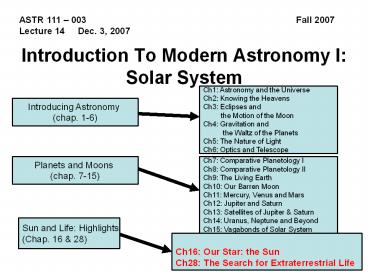Introduction To Modern Astronomy I: Solar System - PowerPoint PPT Presentation
Title:
Introduction To Modern Astronomy I: Solar System
Description:
Title: PowerPoint Presentation Author: Sumanas Last modified by: Jie Zhang Created Date: 12/24/2002 1:08:46 AM Document presentation format: On-screen Show – PowerPoint PPT presentation
Number of Views:152
Avg rating:3.0/5.0
Title: Introduction To Modern Astronomy I: Solar System
1
Introduction To Modern Astronomy ISolar System
ASTR 111 003
Fall 2007 Lecture 14 Dec. 3, 2007
Ch1 Astronomy and the Universe Ch2 Knowing the
Heavens Ch3 Eclipses and the Motion of
the Moon Ch4 Gravitation and the Waltz
of the Planets Ch5 The Nature of Light Ch6
Optics and Telescope
Introducing Astronomy (chap. 1-6)
Planets and Moons (chap. 7-15)
Ch7 Comparative Planetology I Ch8 Comparative
Planetology II Ch9 The Living Earth Ch10 Our
Barren Moon Ch11 Mercury, Venus and Mars Ch12
Jupiter and Saturn Ch13 Satellites of Jupiter
Saturn Ch14 Uranus, Neptune and Beyond Ch15
Vagabonds of Solar System
Sun and Life Highlights (Chap. 16 28)
Ch16 Our Star the Sun Ch28 The Search for
Extraterrestrial Life
2
Our Star, the SunChap. 16
Energy from the Sun sustains life on the Earth
3
Basic Facts
- Diameter 1,400,000 km
- Distance to Earth 1 AU 1.5 X 108 km
- Light travel time 500 seconds
- Angular size 30 arcmin
- Effective Surface Temperature 5800 K
4
Thermonuclear reactions
- Suns total energy output 1026 watts
- Can not be chemical energy (only last 10,000
years) - Can not be gravitational contraction (only last
25 million years) - Energy from nuclear reaction
- Corresponds to a reduction of mass according
Einsteins mass-energy equation E
m c2
5
Thermonuclear reactions
- The Suns energy is produced by hydrogen fusion
a sequence of thermonuclear reactions in which
four hydrogen nuclei combine to produce a single
helium nucleus called proton-proton chain
reaction
6
Thermonuclear reactions
4 H ? He energy neutrinos Mass of 4 H gt Mass
of 1 He
- In every second, 600 million tons of hydrogen
converts into helium to power the Sun - At this rate, the Sun can last for about 10
billion years - It is now 4.6 billion year old
- It will continue the hydrogen burning for at
least another 5 billion years.
The sun itself is extremely stable. It controls
the climate of the Earth
7
Dynamic Atmosphere
- However, the Suns atmosphere is extremely dynamic
8
Dynamic Atmosphere
9
Space Weather the Effects
- Human Space Exploration
Aviation
Satellite Operation
Power
Aurora
Communication and Navigation
10
The Search for Extraterrestrial LifeChap. 28
11
The State of the Universe
- Age 13.7 billion years
- Size
- Composition
- dark energy 73
- dark matter 23
- ordinary matter 4
12
Chemical building blocks of life
- All life on Earth is based on carbon-based
compounds, called organic molecules - These organic molecules occur naturally in the
interstellar clouds of gas and dust, called
nebula, throughout galaxies
13
Liquid Water
- Liquid water may be needed for Earth-like life
- Besides Earth, at least two worlds in our solar
systemthe planet Mars and Jupiters satellite
Europamay have had liquid water
14
The Drake equation
Estimate how many civilizations may inhabit our
Galaxy about 10
1 per year
1
0.1
1
1
1
100 years
15
SearchSearch
Dedicated to search for extraterrestrial
intelligent life (SETI)
ATA Allen Telescope Array of 350-dishes when
completed. 42 dishes now working
Seth Shostak I think we will find signals from
intelligent civilizations by 2025































